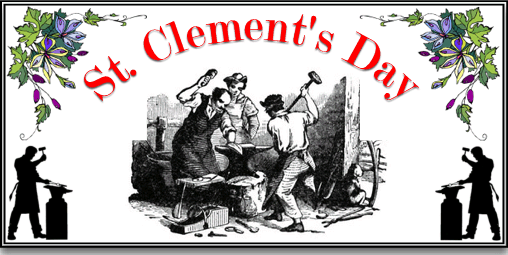
“Come all you Vulcans stout and strong,
Unto St. Clem we do belong,
I know this house is well prepared
With plenty of money and good strong beer,
And we must drink before we part,
All for to cheer each merry heart.
Come all you Vulcans, strong and stout,
Unto St. Clem I pray turn out;
For now St. Clem’s going round the town,
His coach and six goes merrily round.
Huzza, a, a.”
Saint Clement (aka Columban) whom legend has it was martyred when he was thrown into the sea with an anchor tied around his neck. Two of his followers are then said to have assembled a congregation who prayed for the recovery of his body. Miraculously the sea parted and created a dry gap which was said to have been a league long. In this space they found a small chapel inside which was a stone tomb containing his body, beside the coffin lay the anchor which had been tied around the saints neck, the chapel had been built by the angels. In the winter of 860 a missionary diplomat named Constantine supposedly found the mortal remains of St. Clement complete with the anchor and took them back to Constantinople. From here they eventually found their way to Rome for interment in the basilica.
Saint Clement is also the patron saint of blacksmiths and traditionally members of the Worshipful Company and Guild of Blacksmith’s would parade through towns on his saints day – November 23rd. In some places the smiths’ would go from house to house collecting money, the ‘kitty’ would then be taken to the local inn for a day of celebration. It is thought that the tradition died out in the 1940’s but has since seen a revival of sorts on Dartmoor.
The small village of Sticklepath is home to the Finch Foundry which is thought to be the last remaining authentic water powered forge in the country. Sometime in the mid 1900’s the foundry resumed the tradition insomuch as it now annually holds a get together of Westcountry blacksmiths who meet up and hold competitions and observe the traditional ‘anvil firing’ event. Originally this was where two anvils where stacked one above the other, an explosive charge was placed between them and when ignited one shot up high into the air. The day begins with a ‘Blacksmith’s Breakfast’ whereby all the smiths eat a hearty meal ahead of the busy day. The main competition entails each blacksmith being allowed two hours of forge time in which to make an item such as a candlestick, these are then judged in order to find the winner.
Today there another competition called the ‘Great Snail Race’ in which blacksmiths compete to see who can forge a ‘Sticklepath Snail’ in the shortest time. This basically is a metal representation of a snail complete with shell, head and antennae, it needs to be free standing and made from a metal bar 200mm x 10mm – a photo graph of one such ‘Sticklepath Snail’ can be seen on the Finch Foundry’s website – HERE.
For visitors this is an opportunity to see how the Finch Foundry would have operated back in the Victoria era as well as seeing the famous trip hammer in operation.
 Legendary Dartmoor The many aspects past and present of Dartmoor
Legendary Dartmoor The many aspects past and present of Dartmoor
